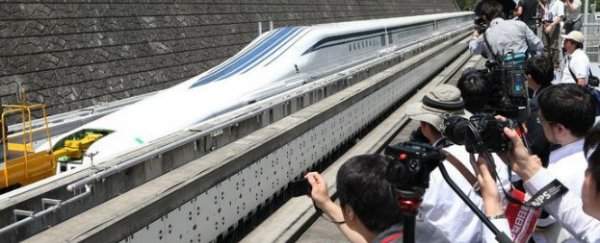A Japanese maglev bullet train owned by the Central Japan Railway Company (JR Central) made history last week by hitting a top speed of 590 k/h (366 mph) on a test run through the Yamanashi prefecture in central Japan.
This beats the previous speed record of 580 k/h (361 mph), which has been standing since December 2003, and a spokesperson for JR Central says they expect to beat the record again tomorrow, when a second test run could hit speeds of 600 k/h.
The train can achieve such ridiculous speeds because rather than running directly on tracks, which causes a whole lot of friction, it's suspended above the rails using very powerful magnetic levitation - "Maglev" is an abbreviation of "magnetic levitation".
Right now, the tracks run between Uenohara and Fuefuki - two cities west of Tokyo - but JR Central plans to expand this to connect Tokyo with Nagoya in the country's centre by 2027. That's when they say the public will be able to ride in this new, super-speedy model, but it'll likely be limited to 500 km/h.
Which still sounds amazing, compared to the speeds we get elsewhere in the world. As Fiona MacDonald reported for us late last year, "Australia is stuck with trains that generally max out at a comparative crawl of around 160 km/h, and in the US, the top speed of rail transport is around 240 km/h."
In fact, the Japanese public have already experienced speeds of over 500 km/h, when an earlier model of the bullet train took 100 lucky passengers on the ride of a lifetime, which actually looked incredibly smooth.
Meanwhile, China is working on something even more outlandish, announcing last year that it's developing a maglev train inside a near-vacuum space that, in theory, could travel 2,900 km/h - three times faster than a plane - due to the lack of air resistance. And Elon Musk's Hyperloop train, designed to transport people across America at speeds of 1,200 km/h might just make it from pipe dream to reality thanks to a super-savvy group of engineers that have recently taken on the project.
Whatever the future holds for transport, one thing's for sure: it's gonna be fast.
Source: The Wall Street Journal
